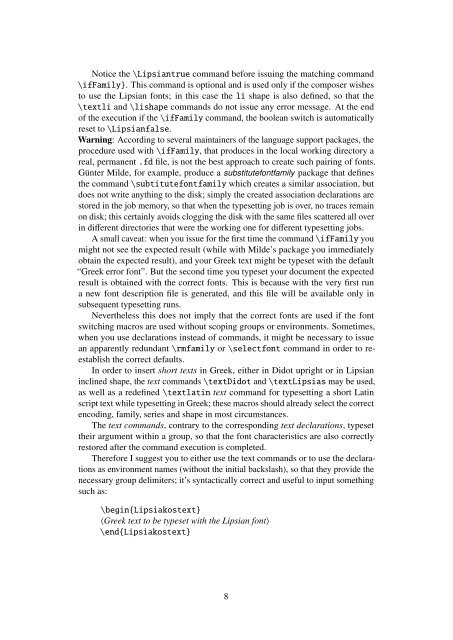teubner-doc.pdf.
teubner-doc.pdf.
teubner-doc.pdf.
Create successful ePaper yourself
Turn your PDF publications into a flip-book with our unique Google optimized e-Paper software.
Notice the \Lipsiantrue command before issuing the matching command\ifFamily}. This command is optional and is used only if the composer wishesto use the Lipsian fonts; in this case the li shape is also defined, so that the\textli and \lishape commands do not issue any error message. At the endof the execution if the \ifFamily command, the boolean switch is automaticallyreset to \Lipsianfalse.Warning: According to several maintainers of the language support packages, theprocedure used with \ifFamily, that produces in the local working directory areal, permanent .fd file, is not the best approach to create such pairing of fonts.Günter Milde, for example, produce a substitutefontfamily package that definesthe command \subtitutefontfamily which creates a similar association, butdoes not write anything to the disk; simply the created association declarations arestored in the job memory, so that when the typesetting job is over, no traces remainon disk; this certainly avoids clogging the disk with the same files scattered all overin different directories that were the working one for different typesetting jobs.A small caveat: when you issue for the first time the command \ifFamily youmight not see the expected result (while with Milde’s package you immediatelyobtain the expected result), and your Greek text might be typeset with the default“Greek error font”. But the second time you typeset your <strong>doc</strong>ument the expectedresult is obtained with the correct fonts. This is because with the very first runa new font description file is generated, and this file will be available only insubsequent typesetting runs.Nevertheless this does not imply that the correct fonts are used if the fontswitching macros are used without scoping groups or environments. Sometimes,when you use declarations instead of commands, it might be necessary to issuean apparently redundant \rmfamily or \selectfont command in order to reestablishthe correct defaults.In order to insert short texts in Greek, either in Didot upright or in Lipsianinclined shape, the text commands \textDidot and \textLipsias may be used,as well as a redefined \textlatin text command for typesetting a short Latinscript text while typesetting in Greek; these macros should already select the correctencoding, family, series and shape in most circumstances.The text commands, contrary to the corresponding text declarations, typesettheir argument within a group, so that the font characteristics are also correctlyrestored after the command execution is completed.Therefore I suggest you to either use the text commands or to use the declarationsas environment names (without the initial backslash), so that they provide thenecessary group delimiters; it’s syntactically correct and useful to input somethingsuch as:\begin{Lipsiakostext}〈Greek text to be typeset with the Lipsian font〉\end{Lipsiakostext}8
















